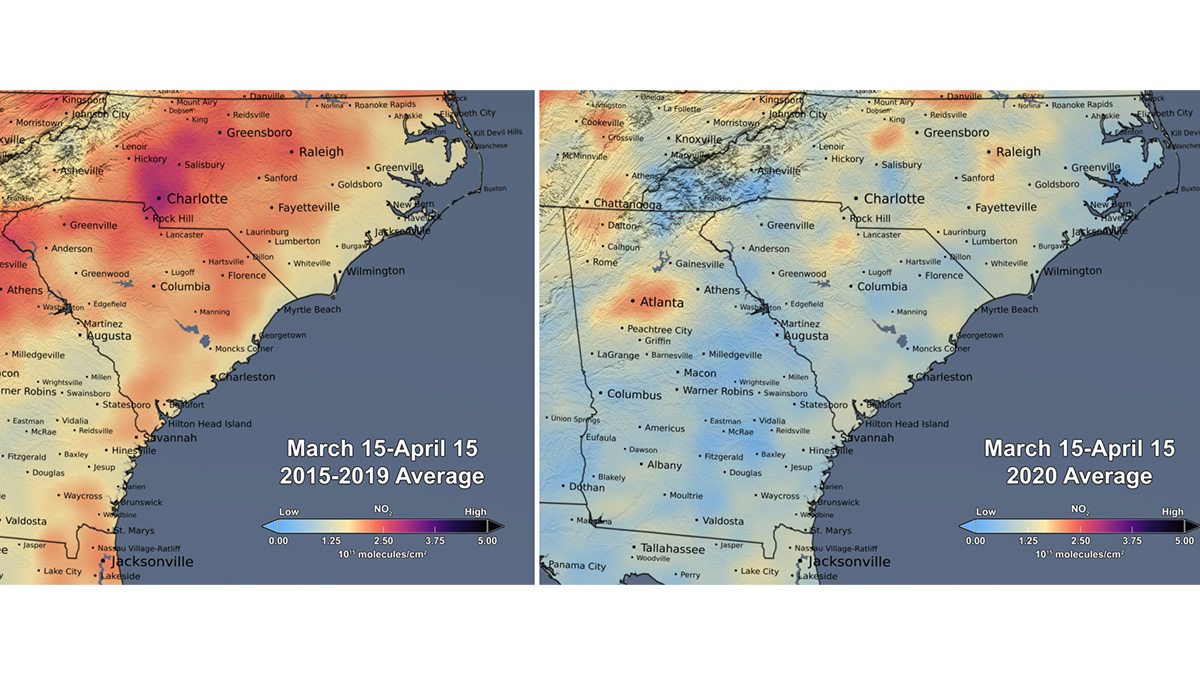In Shutdown, Less Traffic Doesn’t Mean Cleaner Air
As of early April, global carbon emissions decreased by 17%, in part because the COVID-19 shutdown led to a steep decrease in road and air traffic emissions. But while a drop in air emissions sounds positive, Carolina environmental scientist Sarav Arunachalam says the situation is not straightforward.

As the U.S. economy slowed this spring due to the novel coronavirus, an avenue of inquiry is how air emissions changed. One finding is that while passenger vehicle use decreased dramatically, freight traffic increased in some large cities.
“The demand for goods stayed up,” said Sarav Arunachalam, an environmental scientist at the University of North Carolina at Chapel Hill. “Grocery stores, Amazon, and Walmart had business. People were still looking for goods to purchase.”
As of early April, the world’s carbon emissions decreased by 17%, in part because of a 50 to 80% drop in road traffic and 75% drop in air traffic emissions in March.
Prior to the COVID-19 outbreak in the U.S., Arunachalam was working on a project about vehicular emissions in the eastern U.S., broken down by vehicle classes — passenger vehicles, medium-duty trucks, heavy-duty trucks and buses — in each state. The project, which was part of a collaboration seeking to develop the clean energy economy, improve transportation and reduce carbon emissions in the transportation sector, analyzed potential health benefits of transportation policies aimed at curbing climate change.
In the midst of the pandemic, he now wants to know what this change in emissions means for North Carolinians, specifically, and the nation as a whole. Through data modeling, he will quantify the potential reductions in air pollution and human health risks. He warns, though, that while air emission decrease sounds like a positive, the situation is not straightforward.
“If you look at the media right now and some preliminary numbers coming out, there’s a mixed message in terms of understanding ifthe COVID-19 pandemic shutdown has led to improved air quality,” he said. “Just because emissions from the transportation sector goes down does not mean that air quality has improved. I think that’s a key message.”
This is because factories, refineries, power plants, and diesel trucks are still dominant sources of pollution — not passenger vehicles.
Additionally, although vehicle traffic is down, ozone pollution has barely decreased. Not to be confused with stratospheric ozone, which protects the planet from ultraviolet radiation from the sun, ground-level ozone is detrimental to health. This pollutant is the result of a chemical reaction that happens when a vehicular and industrial pollutant, called nitrogen oxide (NOx), reacts with naturally occurring, volatile organic compounds.
Although this process creates ground-level ozone, at a certain point, high levels of NOx actually decrease ozone by temporarily breaking down its molecules.
“Even though you are increasing NOx, you are removing ozone because you have reached a transition point in the chemical process,” Arunachalam explained. “So now, if you’re reducing NOx emissions because there are fewer emissions on the road, then that eating up of the ozone is not happening so the ozone levels will start to go up.”
In a project, currently in the preliminary planning phase, Arunachalam wants to explore these nuances to determine how reduced emissions either have or have not contributed to reduced air pollution. Another study will help determine if the large-scale reduction in aviation emissions during the shutdown has led to tangible, local air quality improvements near airports. He hopes more data will reveal if changes in our behavior have had a significant effect on the environment and will provide insight on future changes needed to combat climate change and public health risk due to air pollution.
While some are hopeful that the pandemic may bring about positive trends in emissions, Arunachalam says it’s important to learn from historical trends. Both the 1918 flu pandemic and the 2008 financial crisis saw drops in emissions — by 15% and 1.5%, respectively. However, once daily life normalized a bit, those numbers actually shot up higher to what they were before these events, increasing by 20% and 5% the following year.
“Given the focus being opening and reviving the economy, I have a suspicion that the government and the powers that be will put the environment and public health on the back burner. By doing all that they can to ramp up the economy, they will relax environmental standards and emissions will go back up. That’s my fear,” he said. “[To prevent this] it has to be a combination of both individual action and, more importantly, collective action at the highest levels.”




